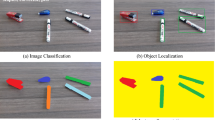Abstract
Foreground detection plays a vital role in finding the moving objects of a scene. For the last two decades, many methods were introduced to tackle the issue of illumination variation in foreground detection. In this article, we proposed a method to segment moving objects under abrupt illumination change and analyzed the merits and demerits of the proposed method with seven other algorithms commonly used for illumination-invariant foreground detection. The proposed method calculates the entropy of the video scene to determine the level of illumination change occurred and select the update model based on the difference in entropy values. Benchmark datasets possessing different challenging illumination conditions are used to analyze the efficiency of the foreground detection algorithms. Experimental studies demonstrate the performance of the proposed algorithm with several algorithms under various illumination conditions and its low time complexity.


Similar content being viewed by others
References
Piccardi M (2004) Background subtraction techniques: a review. IEEE Int Conf Syst Man Cybern 4:3099–3104
Benezeth Y, Jodoin Pierre-Marc, Emile Bruno, Laurent Helene, Rosenberger Christophe (2012) Comparative study of background subtraction algorithms. J Electron Imaging 19(3):12
Ahmed Sumaya H, El-Sayed Khaled M, Elhabian Shireen Y (2008) Moving object detection in spatial domain using background removal techniques-state-of-art. Recent Pat Comput Sci 1(1):32–54
Bouwmans Thierry (2014) Traditional and recent approaches in background modeling for foreground detection: an overview. Comput Sci Rev 11(12):31–66
Sen-ching SC, Chandrika K (2004) Robust techniques for background subtraction in urban traffic video. In: Proceedings of the SPIE 5308, Visual Communications and Image Processing
Li L, Huang W, Irene YH Gu, Qi Tian (2003, November) Foreground object detection from videos containing complex background. ACM International Conference on Multimedia, pp. 2–10
Wahyono A, Filonenko Jo KH (2016) Unattended object identification for intelligent surveillance systems using sequence of dual background difference. IEEE Trans Ind Inf 12(6):2247–2255
Wang K, Liu Y, Gou C, Wang FY (2016) A multi-view learning approach to foreground detection for traffic surveillance applications. IEEE Trans Veh Technol 65(6):4144–4158
Wren CR, Azarbayejani A, Darrell T, Pentland AP (1997) Pfinder: real-time tracking of the human body. IEEE Trans Pattern Anal Mach Intell 19(7):780–785
McFarlane NJB, Schofield CP (1995) Segmentation and tracking of piglets in images. Mach Vis Appl 8(3):187–193
Friedman N, Russell S (1997, August) Image segmentation in video sequences: a probabilistic approach. In: Thirteenth Conference on Uncertainty in Artificial Intelligence, pp. 175–181
Stauffer C, Grimson WEL (1999) Adaptive background mixture models for real-time tracking. IEEE Comput Soc Conf Comput Vis Pattern Recogn 2:252
Cheng FC, Huang SC, Ruan SJ (2011) Illumination-sensitive background modeling approach for accurate moving object detection. IEEE Trans Broadcast 57(4):794–801
Barnich O, Van Droogenbroeck M (2011) ViBe: a universal background subtraction algorithm for video sequences. IEEE Trans Image Process 20(6):1709–1724
Manzanera A, Richefeu JC (2004, December) A robust and computationally efficient motion detection algorithm based on ∑-Δ background estimation. In: Indian Conference on Computer Vision, Graphics and Image Processing, pp. 46–51
Lou J, Yang H, Hu W, Tan T (2002, January) An illumination invariant change detection algorithm. In: Asian Conference on Computer Vision, pp. 13–18
Holtzhausen PJ, Crnojevic V, Herbst BM (2015) An illumination invariant framework for real-time foreground detection. J Real Time Image Process 10(2):423–433
Elharrouss O, Abbad A, Moujahid D, Tairi H (2018) Moving object detection zone using a block-based background model. IET Comput Vis 12(1):86–94
Kim W, Kim Y (2016) Background subtraction using illumination-invariant structural complexity. IEEE Signal Process Lett 23(5):634–638
Toyama K, Krumm J, Brumitt B, Meyers B (1999) Wallflower: principles and practice of background maintenance. IEEE Int Conf Comput Vis 1:255–261
Li Liyuan, Huang Weimin, Irene Yu-Hua Gu, Tian Qi (2004) Statistical modeling of complex backgrounds for foreground object detection. IEEE Trans Image Process 13(11):1459–1472
Author information
Authors and Affiliations
Corresponding author
Rights and permissions
About this article
Cite this article
Karthikeyan, P.R., Sakthivel, P. & Karthik, T.S. Comparative study of illumination-invariant foreground detection. J Supercomput 76, 2289–2301 (2020). https://doi.org/10.1007/s11227-018-2488-1
Published:
Issue Date:
DOI: https://doi.org/10.1007/s11227-018-2488-1




